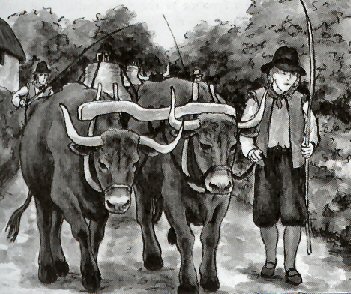

|
The dissolution brought one bonus for Witheridge. In the late 1530's much priory, abbey, and monastery property was sold off. It is known that a John Stephens of Witheridge brought the 'five bells of Barnstaple'. It has been suggested that the religious house for Clunia monks was the source of these bells. As he paid over the going rate for these bells it is unlikely that they were for speculation. The probability is that he gave them to the church at Witheridge; indeed the church certainly had five bells by 1552. John Stephens was a man of strong traditional views, for in 1549 he took up arms for the old Catholic religion as part of the Prayer Book Rebellion, which began in Sampford Courtenay. John was killed in the 'Rebellyon Time', probably at the Clist Heath Battle near Exeter in the August of that year when the rebellion was crushed. The five bells were replaced in 1754. A bell was added in 1800, a further two bells came in 1889, and they were all rehung in 1926. The Dissolution of the Monasteries (sometimes called the Suppression of the Monasteries) was the formal process, taking place between 1536 and 1540, by which King Henry VIII confiscated the property of the Roman Catholic institutions in England for himself as the new head of the Church of England. This happened at about the same time that the Protestant Reformation was taking place in mainland Europe. It has been suggested that getting the lands and treasuries of those religious houses was as much Henry's purpose in splitting with the Church of Rome as getting divorced from Catherine of Aragon; however, the evidence points away from this, since he spent five years pressuring the Pope for his annulment before finally giving up and splitting from Rome. Rather, having gained control over the church, he was unable to resist the temptation to use its wealth to clear the country's debts - especially as the church had an income three times greater than that of the state. In 1534 King Henry had Parliament authorize Thomas Cromwell, a layman, to "visit" all the monasteries (which term includes abbeys and convents), ostensibly to make sure their members were instructed in the new rules for their supervision by the king instead of the pope, but actually to inventory their assets. A few months later, in January 1535 when the consternation at having a lay visitor instead of a bishop had settled down, Cromwell's visitation authority was delegated to a commission of laymen. This phase is termed the "Visitation of the Monasteries." In the summer of that year, the visitors started their work, and "preachers" and "railers" were sent to deliver sermons from the pulpits of the churches on three themes: The monks and nuns in the monasteries were sinful "hypocrites" and "sorcerers" who were living lives of luxury and engaging in every kind of sin there was. Those monks and nuns were sponging off the working people and giving nothing back and, thus, were a serious drain on England's economy. If the king got all the property the abbeys had, he would not need any taxes from the people ever again.Meanwhile, during the last half of 1535, the visiting commissioners were sending back written reports to Cromwell of all the scandalous doings they said they were discovering, some of them sexual, and some of them financial. The law Parliament enacted in early 1536, relying in large part on the reports of impropriety Cromwell had received, provided for the king to take all the monasteries with annual incomes of less than £200, and that was done but did not raise as much capital as had been expected, even after the king re-chartered some of the confiscated monasteries and confiscated them again. In April 1539 a new Parliament passed a law giving the king the rest of the monasteries in England. Some of the abbots resisted, and that autumn the abbots of Colchester, Glastonbury, and Reading were executed for treason in doing so. The other abbots gave in and signed their abbeys over to the king. Some of the confiscated church buildings were destroyed (and many others vandalized, their altars and windows smashed, including irreplaceable stained glass ones, and their tombs stripped and emptied). Other losses to posterity included the many valuable books held in the monastic libraries, virtually all of which were destroyed and their pages used for tasks such as stopping wine casks, polishing candlesticks, or wrapping fish. It is believed that many of the earliest Anglo-Saxon manuscripts were lost at this time. The world-famous Book of Kells was only preserved by being smuggled out of the monastery at great risk by the last Abbot. Monastic schools and hospitals were also lost, with serious consequences locally. Many of the dismantled monasteries and friaries were sold for nominal amounts (often to the local townspeople), and some of the lands the king gave away; there were also pensions to be paid to some of the dispossessed clerics. Although the total value of the confiscated property has been calculated to have been as high as £200,000 at the time, the actual amount of income King Henry received from it from 1536 through 1547 averaged only £37,000 per year, about 20% of what the monks had derived from it. Previous Last Edited 03/07/2006 Copyright © 2000-2006 Witheridge Unless otherwise indicated on the page in question, the photographic images reproduced on this site belong to the Witheridge Archives, and, as such may not be reproduced for commercial purposes without written permission. However, you are welcome to use any of the photographs belonging to the archive for personal and/or non-commercial use. Any material shown as not being owned by the archive may not be reproduced in any form without first receiving written permission from the owner of the material in question. The copyright for the illustration of the Priory Bells belongs to Witheridge Artist and Illustrator Jenny Bidgood. |


